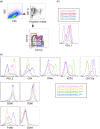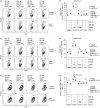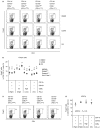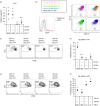Mesenteric lymph node CD11b- CD103+ PD-L1High dendritic cells highly induce regulatory T cells
- PMID: 28423181
- PMCID: PMC5543494
- DOI: 10.1111/imm.12747
Mesenteric lymph node CD11b- CD103+ PD-L1High dendritic cells highly induce regulatory T cells
Abstract
Dendritic cells (DCs) in mesenteric lymph nodes (MLNs) induce Foxp3+ regulatory T cells to regulate immune responses to beneficial or non-harmful agents in the intestine, such as commensal bacteria and foods. Several studies in MLN DCs have revealed that the CD103+ DC subset highly induces regulatory T cells, and another study has reported that MLN DCs from programmed death ligand 1 (PD-L1) -deficient mice could not induce regulatory T cells. Hence, the present study investigated the expression of these molecules on MLN CD11c+ cells. Four distinct subsets expressing CD103 and/or PD-L1 were identified, namely CD11b+ CD103+ PD-L1High , CD11b- CD103+ PD-L1High , CD11b- CD103+ PD-L1Low and CD11b+ CD103- PD-L1Int . Among them, the CD11b- CD103+ PD-L1High DC subset highly induced Foxp3+ T cells. This subset expressed Aldh1a2 and Itgb8 genes, which are involved in retinoic acid metabolism and transforming growth factor-β (TGF-β) activation, respectively. Exogenous TGF-β supplementation equalized the level of Foxp3+ T-cell induction by the four subsets whereas retinoic acid did not, which suggests that high ability to activate TGF-β is determinant for the high Foxp3+ T-cell induction by CD11b- CD103+ PD-L1High DC subset. Finally, this subset exhibited a migratory DC phenotype and could take up and present orally administered antigens. Collectively, the MLN CD11b- CD103+ PD-L1High DC subset probably takes up luminal antigens in the intestine, migrates to MLNs, and highly induces regulatory T cells through TGF-β activation.
Keywords: dendritic cells; intestinal immunity; mesenteric lymph nodes; oral tolerance; regulatory T cells.
© 2017 John Wiley & Sons Ltd.
Figures







Similar articles
-
A new subset of CD103+CD8alpha+ dendritic cells in the small intestine expresses TLR3, TLR7, and TLR9 and induces Th1 response and CTL activity.J Immunol. 2011 Jun 1;186(11):6287-95. doi: 10.4049/jimmunol.1004036. Epub 2011 Apr 27. J Immunol. 2011. PMID: 21525388
-
Age-Dependent Decrease in the Induction of Regulatory T Cells Is Associated With Decreased Expression of RALDH2 in Mesenteric Lymph Node Dendritic Cells.Front Immunol. 2020 Aug 11;11:1555. doi: 10.3389/fimmu.2020.01555. eCollection 2020. Front Immunol. 2020. PMID: 32849526 Free PMC article.
-
Preferential expression of integrin αvβ8 promotes generation of regulatory T cells by mouse CD103+ dendritic cells.Gastroenterology. 2011 Nov;141(5):1813-20. doi: 10.1053/j.gastro.2011.06.076. Epub 2011 Jul 13. Gastroenterology. 2011. PMID: 21745448 Free PMC article.
-
Intestinal CD103+ dendritic cells: master regulators of tolerance?Trends Immunol. 2011 Sep;32(9):412-9. doi: 10.1016/j.it.2011.06.003. Epub 2011 Aug 2. Trends Immunol. 2011. PMID: 21816673 Review.
-
Dendritic cells as controllers of antigen-specific Foxp3+ regulatory T cells.J Dermatol Sci. 2009 May;54(2):69-75. doi: 10.1016/j.jdermsci.2009.02.001. Epub 2009 Mar 14. J Dermatol Sci. 2009. PMID: 19286352 Free PMC article. Review.
Cited by
-
Functions of Dendritic Cells and Its Association with Intestinal Diseases.Cells. 2021 Mar 6;10(3):583. doi: 10.3390/cells10030583. Cells. 2021. PMID: 33800865 Free PMC article. Review.
-
Early life imprinting of intestinal immune tolerance and tissue homeostasis.Immunol Rev. 2024 May;323(1):303-315. doi: 10.1111/imr.13321. Epub 2024 Mar 19. Immunol Rev. 2024. PMID: 38501766 Free PMC article. Review.
-
Human Dendritic Cells: Their Heterogeneity and Clinical Application Potential in Cancer Immunotherapy.Front Immunol. 2019 Jan 21;9:3176. doi: 10.3389/fimmu.2018.03176. eCollection 2018. Front Immunol. 2019. PMID: 30719026 Free PMC article. Review.
-
Immunosuppressive Polymeric Nanoparticles Targeting Dendritic Cells Alleviate Lupus Disease in Fcgr2b-/- Mice by Mediating Antigen-Specific Immune Tolerance.Int J Mol Sci. 2023 May 5;24(9):8313. doi: 10.3390/ijms24098313. Int J Mol Sci. 2023. PMID: 37176021 Free PMC article.
-
Sublingual Immunotherapy: How Sublingual Allergen Administration Heals Allergic Diseases; Current Perspective about the Mode of Action.Pathogens. 2021 Feb 2;10(2):147. doi: 10.3390/pathogens10020147. Pathogens. 2021. PMID: 33540540 Free PMC article. Review.
References
-
- Hori S. Lineage stability and phenotypic plasticity of Foxp3+ regulatory T cells. Immunol Rev 2014; 259:159–72. - PubMed
MeSH terms
Substances
LinkOut - more resources
Full Text Sources
Other Literature Sources
Molecular Biology Databases
Research Materials
Miscellaneous

